Bunchosia MALPIGHIACE Æ; Barbados Cherry Family
Two species share common names (Peanut-butter Fruit or Peanut-butter Plant) and confusingly similar scientific names: Bunchosia argentea and Bunchosia Armeniaca. Therefore, I sought to learn what’s the difference? Which is more commonly cultivated? This article shares my findings. The reason I care is because the plants bear pretty yellow blossoms and red edible fruit.
The English name Peanut-butter Plant is applied to at least four plant genera: Melianthus major (leaf scent); Clerodendrum trichotomum (leaf scent), Glyptopleura marginata (leaf flavor), and Bunchosia spp. (fruit flavor). It is only the latter that I write about here.
All 55 – 80 Bunchosia species are from tropical or subtropical Mexico, the West Indies, and South America. The generic name Bunchosia dates from 1822, when these plants were segregated from the 1753 genus Malpighia. The genus Malpighia and family MALPIGHIACE!Æ commemorate Marcello Malpighi (1628 – 1694), distinguished Italian doctor and naturalist, who wrote on the anatomy of plants. George Don in 1831 explained: “Bunchosia, from Bunchos, the Arabic name for coffee, in allusion to the similarity between the seeds of this genus and those of coffee.”
From what I learned, of the few Bunchosia species that I studied, the one named (B. Armeniaca), has been cultivated sparingly, for fruit and ornament, in NW South America, and is, at certainly nominally, less cultivated and less known in the U.S. than another species (B. glandulifera — usually misidentified in U.S. horticulture as Bunchosia argentea). True Bunchosia argentea is fairly common in NW South America and is not cultivated there or elsewhere.
Bunchosia glandulifera (Jacq.) Kunth 1822 = Malpighia glandulifera Jacq. 1790
This species, compared to Bunchosia Armeniaca, is apparently more commonly cultivated in the United States (and certainly so in South America). It is not hard to find web sites and nurseries that discuss it under the name Bunchosia argentea and show photos of it. Perhaps native in northern Venezuela and Colombia, it is widely cultivated for its fruit elsewhere in northern South America. It has been called in French café moka and café bois, and in Spanish Ciruela. George Don in 1831 wrote that it had been cultivated in Europe since 1806. It is a shrub or small tree to 25 feet tall. The leaves are lightly hairy, and measure up to up to 18 by 12cm [7 by 4.75 inches], with wavy edges. The fruit can be an inch and an eighth in length.
The leaf hairs on the specimen that I purchased from Logee’s Greenhouses of Connecticut, are very short, sparse, and tiny. The photos seen using Google’s image search, show many plants that look like the one I bought. Again, the leaves of Bunchosia Armeniaca are hairless, while those of the real Bunchosia argentea are densely silky with hairs.
Assuming for the moment that the plants being sold and described and photographed under the name Bunchosia argentea appear to be misidentified specimens of Bunchosia glandulifera, below are examples of what is being written of them:
Cornucopia II (1998): Fruit about the size of a quail egg, reddish orange, not very juicy, but with concentrated sugars much like a dried fig or American persimmon.
Logee’s: “During the 1st year it should bloom several times March thru October. Once mature (8-10 inch pot), they will produce yellow flowers that turn into 1 inch fruits that ripen red. Fruits have soft, sweet, dense pulp and a large seed. The plants are naturally upright and for good fruit set, need warmth & sun. In the North, container-grown plants yield fruit by the fall –if in a greenhouse or conservatory with abundant heat, earlier. Zone 10 & higher outside. Grows 3-6 feet in container, min. temp. inside 40 degrees F.”
Frankies nursery (HI): fast growing small tree. Attractive clusters of yellow flowers; abundant 1 inch fruits which turn red upon maturity.
FruitLovers.com (HI): “The fruits are orange when ripe and the size of a peanut. The tree likes full sun but can take some shade. Plant 12 feet apart. Good to pick when the fruits are just starting to turn orange but stillhard. Let ripen fully indoors. Fully ripe when totally soft.”
Daleysfruit.com.au: “Highly underestimated. Apart from being a valuable tree for the fruit it bears it is also highly ornamental. It can be grown into a bush or a small tree with a tendency to go deciduous during the winter. The yellow flowers are produced through late Spring and are followed by a nearly constant production of fruits in varying quantities. The dark-red to dark-orange fruit is the size of a quail egg and needs to be picked every day as they spoil quickly on the tree. They can be stored for several days in the refrigerator or can be separated from the seed and frozen. The skin is very tender with rich, sweet flesh that has a texture very similar to peanut butter or a sweet potato. The concentrated sugars of the fruit make it much like a dried fig. They are especially good when blended into a milkshake. The trees, which have a distant affinity to the Acerola Cherry, are hardy and highly tolerant of frost. They grow quickly and produce from their first year.”
The photos I show are on the specimen that I bought in September 2010 from Logee’s Greenhouses. As you can see, in the 8+ months I have had it as a houseplant, it has grown larger. When it flowers I will take pictures.
If by chance any readers have tasted the fruits of more than one of the three aforementioned species, and care to share opinions as to the relative merits, I welcome such news. If you desire a great deal more information on this genus, including photos, the definitive website is: http://herbarium.lsa.umich.edu/malpigh/BunClade/Bunchosia/Bun1.html
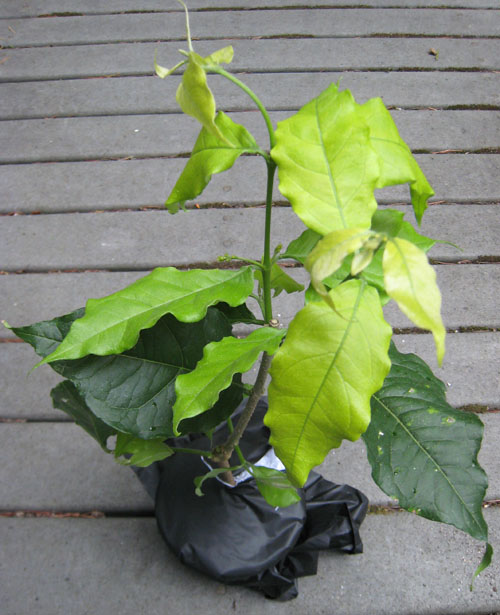
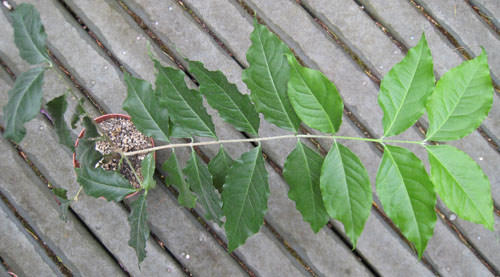
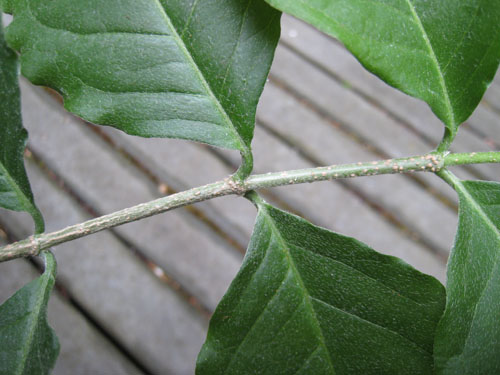
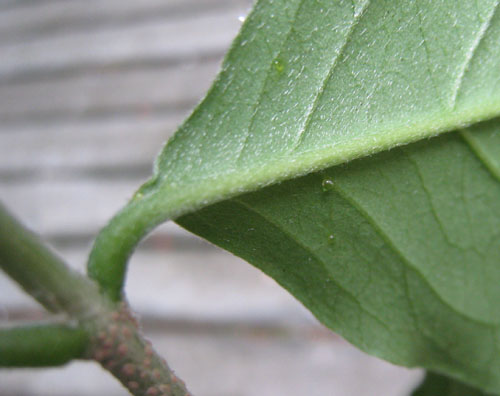
About Arthur Lee Jacobson
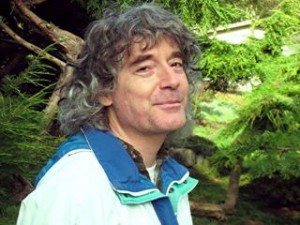 A lifelong Seattle resident, Arthur developed a passion for plants at 17 and has made his living growing, photographing, and writing about plants. He is a rare expert who can speak about wild plants, garden plants, and house plants.
A lifelong Seattle resident, Arthur developed a passion for plants at 17 and has made his living growing, photographing, and writing about plants. He is a rare expert who can speak about wild plants, garden plants, and house plants.
Arthur has a special interest in edible plants, and, in his field guide Wild Plants of Greater Seattle, he includes comments on the edibility, taste, and uses of plants found in the city.
For more information, visit Arthur Lee Jacobson’s website.
Photos © Arthur Lee Jacobson

My very young tree (in Hawaii) is attractive, fast growing and flowering in less than a year from putting in the ground. I am excited to try the fruit, and am under the impression that the flesh contains oil. Is this true? Olives and avocado are the only oily fruits that I know of. If it does, this is good news for fruit lovers.
I do not know if the flesh has a good oil. Numerous fruits besides olives and avocados can yield edible oils. A list of many plant genera yielding fatty oils is on page 372 of The Dictionary of Economic Plants 2nd ed. 1968. Most oils people use for cooking are derived from seeds.
At least 19 species of Bunchosia have their fruit reported eaten by humans. I found no record of the seeds being eaten; one old source that stated that some person or people believed the seeds of at lest one species poisonous. In general, the entire family is relatively safe. I expect that careful sampling of seeds is not apt to have adverse effects.
I do not know the seeds are poisonous but have tried eating the fruits while they are still crunchy, taste like carrot, with the seeds.Even my neighbors have also tried eating the fruits with the seeds,we are still alive. I even tried drying the seeds and roased them, tasted like peanut only a litle different. Is it really poisonous?
I am IGEE from Kerala INDIA. I have planted Peanut Butter Fruit plant (small) 4 months back in a pot. That plant flowered and fruited,I have taken photos also. I like to upload the same.
I had tasted the orange shell as well as the seed, whether the seed poisonous.
Please reply
Igee,
Please send photos via email and I will add them to your comment. Arthur asked to see them.
Thank you!
Gail N-K
Co-Publisher, GoodFood World
Can the nut of the peanut butter fruit be eaten raw?
Sandra,
According to this article on Arthur Lee’s website, “The seed or pit is said to be poisonous.”
Take care.
Gail N-K
Co-Publisher, GoodFood World
In June, 2012, my plant began blooming, with many dozens of flowers over months, none of which set fruit. It may need to be hand-pollinated; it may need to be older; it may need pollen from another individual specimen. Maybe its fertilizer ought to be lower in nitrogen, higher in phosphorus and potassium.
Hello, Thanks for doing the research for me. DId yours ever fruit? How long till fruiting maturity?
Thanks